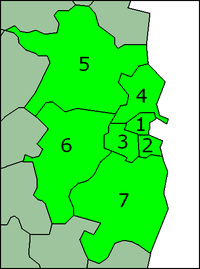Greater Dublin Area

|
Greater Dublin Area (GDA), or simply Greater Dublin, is a term which is used to describe the city of Dublin and the counties of Dun Laoghaire-Rathdown, Fingal, Kildare, Meath, South Dublin and Wicklow of the Republic of Ireland.
Introduction
The term is described in the Planning and Development Act, 2000 (Section 21) and a number of other statutory instruments for the purposes of planning and development throughout the area. The area is covered in these contexts by the combined "Dublin Regional Authority" and "Mid-East Regional Authority". The city and five counties are also mentioned in the order creating the Dublin Transportation Office, giving functions and representations to the office in the Greater Dublin Area, though not using the term.
The Greater Dublin Area covers an area of 6,980km².
Alternatives
Greater Dublin Area is often used interchangeably, but somewhat inaccurately, with the term "Dublin Region" — the area of the four Dublin local authorities under the Local Government Act, 1991 (Regional Authorities) (Establishment) Order, 1993; and the term "Dublin Metropolitan Area" — the urban part of Dublin as defined by various statutory instruments, mainly those referring to the Garda Síochána and court proceedings.
Population
The population of the Greater Dublin Area as of Census 2006 was 1,661,185 persons. Estimates published by the Central Statistics Office suggest that the population of the Greater Dublin Area will reach two million by 2021. The figures are based on a regional breakdown of previously published national population projections and assume that current demographic trends will continue.
Historical
- 1996: 1,405,671
- 2002: 1,565,446
- 2006: 1,661,185
